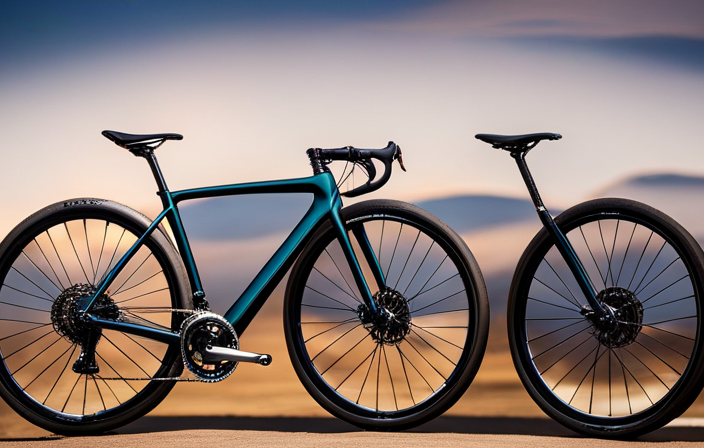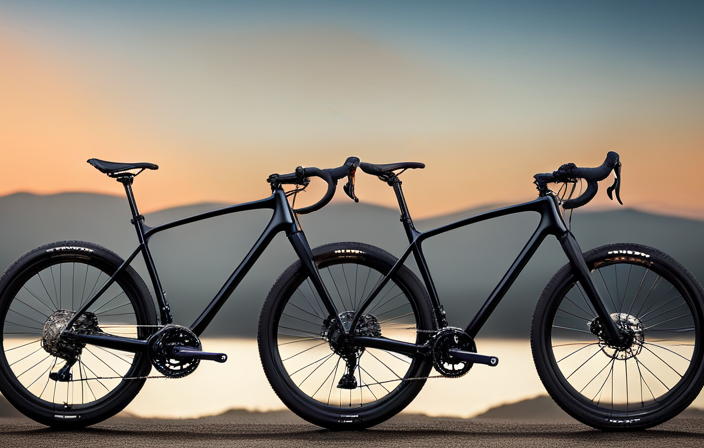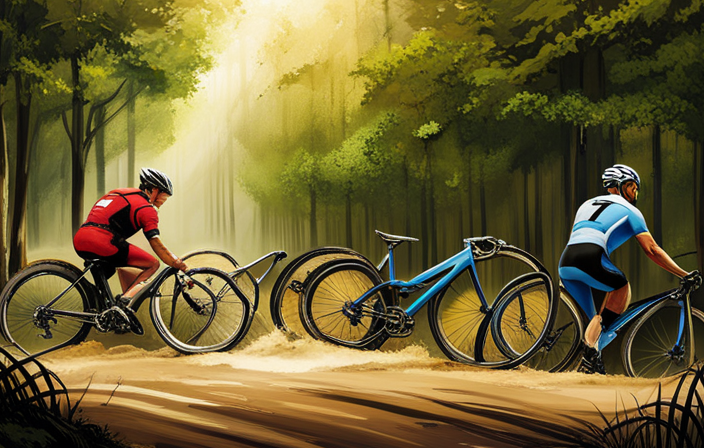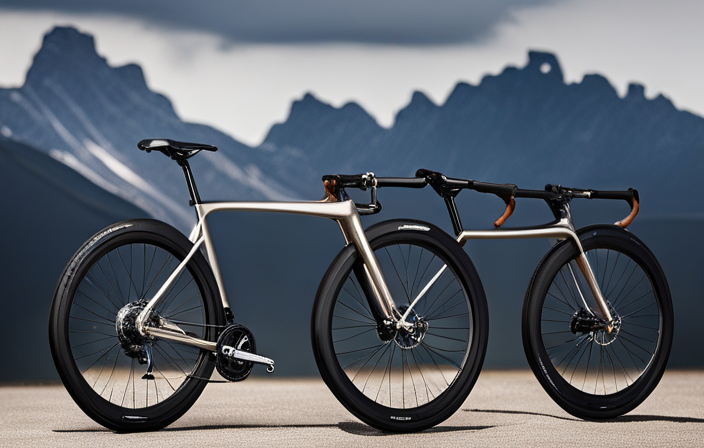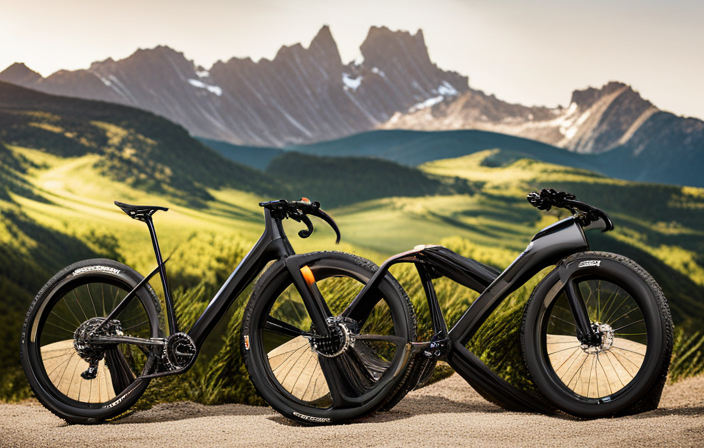Are you aware that gravel biking has become one of the most rapidly growing cycling disciplines, with a 71% surge in popularity in the last ten years?
If you’re looking to venture off-road and explore unpaved paths, selecting the right bike for gravel is essential.
In this article, I will guide you through the process of choosing a bike that suits your riding style and budget, considering factors like frame material, tire size, braking system, handlebars, and more.
Let’s dive in and find your perfect gravel companion!
Key Takeaways
- Gravel biking requires endurance, stability, and control, with wider tires and stable handling characteristics being essential.
- When determining your budget for a gravel bike, prioritize essential components like frame quality, brakes, and drivetrain, and make an informed decision based on your needs and financial capabilities.
- Consider the bike’s frame material, taking into account factors such as weight, comfort, maneuverability, and shock absorption capabilities.
- Evaluate the bike’s geometry, tire size and width, components, suspension options, brake options, handlebar options, and additional features to find a bike that suits your riding style and preferences.
Understand the Terrain and Riding Style
To choose the right bike for gravel, it’s important to understand the terrain and your riding style. Riding techniques and trail conditions play a crucial role in determining the type of bike that will best suit your needs.
When it comes to riding techniques, gravel biking requires a different set of skills compared to road or mountain biking. It involves a combination of endurance, stability, and control. Gravel roads can be unpredictable with loose surfaces and uneven terrain. Therefore, having a bike with wider tires and stable handling characteristics is essential. This will provide better traction and control as you navigate through various obstacles such as rocks, roots, and potholes.
Trail conditions also influence what kind of bike you should choose for gravel riding. If you plan on tackling rougher terrains with more challenging trails, a bike with suspension might be beneficial. It helps absorb shocks from bumps and impacts, allowing for a smoother ride. However, if you mainly stick to well-maintained gravel paths or less technical routes, a rigid frame bike may suffice.
Now that we have covered understanding the terrain and riding style aspect of choosing the right gravel bike, let’s move on to determining your budget for this exciting new adventure into off-road cycling.
Determine Your Budget
Once you’ve figured out your budget, it’s easier to narrow down your options for a bike suitable for gravel riding. Determining your bike budget is an important step in the process of selecting the right bike for you. It helps you set realistic expectations and ensures that you get the best value for your money.
To help you with budgeting, here are some tips to consider:
-
Set a realistic range: Determine how much you are willing to spend on a gravel bike. Consider factors such as frequency of use, desired features, and longevity of the bike.
-
Prioritize essential components: Allocate a larger portion of your budget towards crucial components like frame quality, brakes, and drivetrain. These elements directly impact performance and durability.
-
Research prices: Look at different brands and models within your budget range. Compare prices online and visit local stores to get an idea of what is available within your price range.
By carefully considering these budgeting tips, you can ensure that you make an informed decision while choosing a gravel bike that meets both your needs and financial capabilities.
When it comes to choosing the right bike frame material…
[Transition into subsequent section about ‘choose the right bike frame material’]Choose the Right Bike Frame Material
Consider your riding preferences and priorities when choosing the ideal frame material for your gravel bike. The bike frame material plays a significant role in determining the overall performance and comfort of your ride. There are several options available, each with its own set of advantages and considerations.
One important factor to consider is the weight of the bike frame material. Lighter materials, such as carbon fiber or titanium, offer enhanced maneuverability and speed on gravel terrain. These materials excel in providing a responsive ride experience while maintaining durability. On the other hand, aluminum frames are more affordable and relatively lightweight, making them a popular choice among riders who prioritize cost-effectiveness.
Another consideration is the level of comfort you seek during your rides. Steel frames are known for their excellent shock absorption capabilities, making them a great option for rough gravel roads. They provide a smooth and stable ride by dampening vibrations from uneven surfaces.
In conclusion, when selecting a bike frame material for your gravel bike, take into account factors like weight and comfort to ensure an optimal riding experience.
Now that we have covered the importance of frame materials, let’s transition into considering the bike’s geometry when choosing the perfect gravel bike.
Consider the Bike’s Geometry
The bike’s geometry is an essential factor to take into account when choosing the ideal gravel ride. The way a bike is designed and shaped affects how it handles on different terrains, making it crucial to consider the geometry before making a purchase.
Here are three key elements of bike geometry that you should pay attention to:
-
Frame angles: The angles of the frame, such as the head tube angle and seat tube angle, determine how the bike feels and performs. Steeper angles provide quicker handling, while slacker angles offer more stability.
-
Wheelbase: The distance between the front and rear axles plays a role in how stable or nimble a bike feels. A longer wheelbase provides better stability for long rides, while a shorter wheelbase offers quicker maneuverability.
-
Stack and reach: These measurements indicate the vertical (stack) and horizontal (reach) dimensions of a bike’s frame. They help determine if the bike will fit your body proportions properly.
Considering these aspects of bike geometry will ensure that you find a ride that suits your riding style and preferences.
Now, let’s move on to deciding on the bike’s tire size and width for optimal gravel performance.
Decide on the Bike’s Tire Size and Width
To choose the ideal tire size and width for your bike, think about what type of terrain you’ll be riding on and how much traction and stability you’ll need. The tire size and width play a crucial role in determining how well your bike performs on gravel roads. Generally, wider tires offer more stability and better traction on loose surfaces, while narrower tires are faster on smoother surfaces.
When selecting tire size and width, consider the following factors: tire pressure and tubeless setup. Lower tire pressure allows for increased grip on uneven terrain by conforming to the surface bumps. It also helps absorb shocks from rough gravel roads, providing a more comfortable ride. Additionally, opting for a tubeless setup reduces the risk of flats as it eliminates the inner tubes that are susceptible to punctures.
To give you a clearer picture, here’s a comparison table showcasing different tire sizes and widths:
| Tire Size | Tire Width (mm) |
|---|---|
| 700c | 32-40 |
| 650b | 47-54 |
| 27.5" | 2.0-2.25 |
Remember, finding the right balance between traction, stability, speed, and comfort is essential when choosing your bike’s tire size and width for gravel riding.
Looking for durable components? Let’s explore that next!
Look for Durable Components
When choosing durable components, prioritize reliability and longevity. One important aspect is the bike frame material. Different materials have different levels of durability and performance. For example, aluminum frames are lightweight and resistant to rust, making them popular for gravel bikes. Carbon fiber frames offer excellent strength and stiffness while still being lightweight, but they can be more expensive. Steel frames are known for their durability and ability to absorb vibrations from rough terrain, but they tend to be heavier.
In addition to the frame material, look for other durable components such as strong wheels with sturdy rims that can withstand the demands of off-road riding. Seek out high-quality drivetrain components like a reliable chainring system and durable derailleurs that can handle the rough conditions encountered during gravel rides.
Transitioning into considering suspension options: Now that we’ve covered the importance of durable components in selecting a gravel bike, let’s move on to another crucial consideration: suspension options.
Consider Suspension Options
Consideration should be given to the suspension options available for a more comfortable and controlled ride on rough terrain. When selecting a bike for gravel, understanding the different suspension types can greatly enhance your overall riding experience. Here are three common suspension setups to consider:
1) Rigid Fork: This is the most basic option with no suspension at all. While it offers simplicity and low maintenance, it may not provide as much comfort on bumpy surfaces.
2) Front Suspension (Hardtail): These bikes have a suspension fork in the front but do not have rear suspension. They offer improved shock absorption at the front, making them suitable for less technical terrains.
3) Full Suspension: These bikes feature both front and rear suspension systems, offering maximum comfort and control on rough terrain. The added shock absorption helps maintain traction and reduces fatigue during long rides.
Each suspension type has its own benefits and drawbacks depending on your riding style and preferences. Consider the type of terrain you’ll be tackling most often to find the right setup that suits your needs.
When transitioning into finding the right gear ratio, it’s important to ensure that your bike’s components work harmoniously with its suspension system for optimal performance.
Find the Right Gear Ratio
When it comes to selecting a bike for gravel riding, finding the right gear ratio is essential. Gear ratio refers to the relationship between the number of teeth on your front chainring and the number of teeth on your rear cassette. This determines how easy or hard it is to pedal and can greatly affect your performance on different terrains.
To choose the ideal gear ratio, you need to consider factors such as the type of gravel terrain you’ll be riding on, your fitness level, and personal preferences. A lower gear ratio with smaller chainrings and larger cogs will provide easier pedaling for steep climbs or rough surfaces. On the other hand, a higher gear ratio with larger chainrings and smaller cogs will be more efficient for flat or smooth sections.
Once you have selected the appropriate gear ratio, mastering gear shifting techniques is crucial. Knowing when to shift gears and how to do so smoothly will ensure that you maintain an optimal cadence throughout your ride. Practice shifting gears while pedaling lightly to avoid putting too much stress on your drivetrain.
Now that we’ve covered finding the right gear ratio and learning proper gear shifting techniques, it’s time to take these bikes out for a test ride! Let’s see how they handle different terrains in our next section.
Test Ride Different Bikes
Let’s hop on various bikes and see how they perform on different terrains during a test ride. There are several benefits to taking the time for a test ride before purchasing a gravel bike. Firstly, it allows you to experience firsthand how the bike handles different surfaces such as gravel, dirt, or pavement. This way, you can assess its stability and comfort level in real-world conditions. Secondly, a test ride gives you the opportunity to evaluate the bike’s responsiveness and maneuverability, which are crucial when riding on unpredictable off-road paths.
To make the most of your test ride, here are some helpful tips:
- Start by adjusting the bike to fit your body properly.
- Ride on various types of terrain that mimic your intended usage.
- Pay attention to how the bike absorbs vibrations and impacts.
- Test out different gears and see if they suit your riding style.
- Take note of any discomfort or issues during the ride.
By following these tips, you’ll have a better understanding of which gravel bike suits your needs best. It ensures that you select a bike that feels comfortable and performs well on diverse terrains.
Now let’s consider the weight of the bike as another important aspect in choosing your ideal gravel companion.
Consider the Bike’s Weight
To make the most informed decision, you should take into account the weight of the bike. The weight of your gravel bike can significantly impact your riding experience and performance on different terrains. A lighter bike will be easier to handle and maneuver, especially when tackling steep inclines or technical sections. It can also contribute to a more enjoyable ride, reducing fatigue over long distances.
When considering the weight of a gravel bike, it’s important to look at various factors that contribute to its overall weight. One such factor is the bike’s suspension system. Gravel bikes typically have either a rigid fork or some form of suspension in the front like a suspension fork or even a flexible frame design for added comfort. These suspension components can add extra weight to the bike but provide improved shock absorption on rough surfaces.
Another aspect to consider is the bike’s gear ratio. A lower gear ratio allows you to tackle challenging terrain with less effort by providing easier pedaling options. However, bikes with wider gear ranges tend to have more components and may weigh slightly more than those with narrower ranges.
Considering both the bike’s suspension and gear ratio when evaluating its weight will help you find a balance between comfort and performance on gravel trails.
Now, let’s explore another important aspect: looking for mounting options…
Look for Mounting Options
One important aspect to consider is the availability of mounting options on your chosen bike. Mounting options refer to the various places on the bike where you can attach different accessories. These accessories can include things like water bottle holders, racks for carrying additional gear, and fenders to protect against mud and debris. Having ample mounting options is crucial, as it allows you to customize your bike according to your specific needs.
When selecting a gravel bike, look for models that have multiple mounting points on both the frame and fork. This will give you the flexibility to add accessories as needed. It’s also worth considering what type of accessory compatibility the bike offers. Some bikes may have proprietary mounting systems that limit your choices when it comes to adding certain accessories.
Having a variety of mounting options not only enhances the functionality of your bike but also increases its versatility. Whether you’re planning long-distance adventures or simply need extra storage space for daily commuting, having the ability to mount different accessories will greatly enhance your riding experience.
Considering the availability of mounting options is just one piece of the puzzle when choosing a gravel bike. Another important factor to consider is the bike’s braking system…
Consider the Bike’s Braking System
Make sure you consider the braking system of your chosen bike when making your decision. The braking system is an essential component of any bike, and it plays a crucial role in ensuring your safety while riding on gravel terrain. When it comes to gravel bikes, there are two main types of braking systems: rim brakes and disc brakes.
Rim brakes exert pressure on the sides of the wheel’s rim to slow down or stop the bike. They are lightweight, easy to maintain, and less expensive compared to disc brakes. However, they may not perform as well in wet or muddy conditions, as water can affect their stopping power.
On the other hand, disc brakes offer more consistent and reliable stopping power regardless of the weather conditions. They use a rotor attached to the hub of the wheel and calipers that squeeze brake pads onto the rotor. This design provides better modulation and control over braking force. Disc brakes come in two types: mechanical (cable-actuated) and hydraulic (fluid-actuated). Hydraulic disc brakes generally offer better performance but can be more expensive.
Considering these pros and cons, I recommend going for a gravel bike equipped with disc brakes for optimal stopping power and control on varied terrains.
Now let’s move on to discussing how to choose the right handlebars for your gravel bike…
Choose the Right Handlebars
When choosing the handlebars for your gravel bike, it’s important to consider factors such as comfort and riding style. Handlebar shapes play a significant role in determining both riding comfort and control. There are various handlebar shapes available, each offering a different hand position and grip.
For example, drop bars provide multiple hand positions that can enhance comfort during long rides. On the other hand, flat or riser bars offer a more upright riding position, which may be preferable for riders who prioritize control on rough terrains.
In addition to handlebar shape, handlebar width also plays a crucial role in gravel riding performance. Wider handlebars provide better stability and control when navigating through unpredictable off-road conditions. They allow you to have more leverage on the bike, making it easier to maneuver over obstacles and maintain stability on loose surfaces.
As you consider these factors when choosing your handlebars, keep in mind that your personal preferences should also be taken into account. Everyone has a different riding style and comfort level, so it’s essential to test out different handlebars before making a final decision.
Now that we’ve discussed how to choose the right handlebars for your gravel bike, let’s move on to considering additional features and accessories that can further enhance your gravel riding experience.
Consider Additional Features and Accessories
To further enhance your experience while riding on gravel, you should consider incorporating additional features and accessories into your setup. These bikepacking gear essentials can make your rides more comfortable, convenient, and enjoyable:
-
Frame bags: These bags provide extra storage space for carrying essential items like tools, spare tubes, snacks, and clothing. They are designed to fit securely on the frame of your bike without interfering with your pedaling.
-
Handlebar bags: These bags attach to the handlebars and offer easy access to items you may need on the go, such as a camera or a map. They help distribute weight evenly and keep your belongings within reach.
-
Seat packs: Seat packs are mounted under the saddle and provide ample storage for larger items like sleeping gear or clothing layers. They are designed to be aerodynamic and stable even on rough terrain.
-
Fenders: Gravel roads can get muddy quickly, so having fenders installed can protect you from getting splashed by dirty water or mud kicked up by your tires.
By equipping yourself with these essential bikepacking gear items, you’ll be well-prepared for any adventure on gravel roads.
In the next section about consulting with experts and reading reviews, we will explore how to gather valuable insights before making a final decision on selecting a bike for gravel riding.
Consult with Experts and Read Reviews
Consider seeking advice from experts and checking out reviews to gather valuable insights before making a final decision on the best gear for your gravel riding adventures. Consulting with experts who specialize in gravel biking can provide you with expert knowledge about the different types of bikes available, as well as their features and performance capabilities. These experts can guide you towards selecting a bike that suits your specific needs and preferences.
Additionally, reading reviews from experienced gravel bikers can give you important information about the reliability and performance of different bike models. Reviews often highlight the pros and cons of each bike, allowing you to make an informed decision based on real-world experiences.
To further illustrate the benefits of consulting with experts and reading reviews, consider the following table:
| Consultation Benefits | Review Reliability |
|---|---|
| Expert guidance | Real user feedback |
| Personalized recommendations | Performance evaluations |
| Knowledge about latest trends | Comparative analysis |
By consulting with experts and reading reliable reviews, you can gain a comprehensive understanding of different bike options for gravel riding. This will help you make an informed decision when selecting a bike that meets your specific needs, ensuring an enjoyable and successful gravel riding experience.
Frequently Asked Questions
Are there any specific brands or models that are recommended for gravel riding?
When it comes to gravel riding, there are several recommended brands and top models that stand out. Some popular choices include the Specialized Diverge, the Trek Checkpoint, and the Cannondale Topstone.
These bikes are specifically designed for off-road adventures, with features like wider tires for better traction and more stable geometry. Each brand offers different models at various price points, so you can find one that fits your budget and preferences.
How often should I expect to replace the tires on a gravel bike?
On average, I find that the lifespan of tires on a gravel bike is around 1500 to 2000 miles. However, this can vary depending on several factors.
The type of terrain you ride on, tire pressure, and your riding style all play a role in how quickly your tires wear out. Rougher surfaces and higher speeds can lead to faster wear.
Regularly inspecting your tires for signs of wear and replacing them when necessary is crucial for optimal performance and safety.
What are the benefits of a suspension fork on a gravel bike?
The benefits of a suspension fork on a gravel bike are numerous. Firstly, it provides increased comfort and control over rough terrain by absorbing shocks and vibrations. This allows for a smoother ride, reducing fatigue and improving overall performance.
Secondly, it enhances traction and stability on uneven surfaces, ensuring better handling and maneuverability.
To properly maintain a suspension fork for gravel riding, regular cleaning, lubrication, and inspection of the seals and stanchions are crucial to ensure optimal functionality and longevity.
Can I use a gravel bike for road cycling as well?
Yes, a gravel bike can be used for road cycling as well. While it may not have the same speed and efficiency as a dedicated road bike, a gravel bike is versatile enough to handle both terrains.
It offers a more relaxed and comfortable riding position, wider tires for better stability, and the ability to tackle rougher surfaces with ease.
While not necessary, having a gravel-specific bike can enhance your off-road experience with features like increased tire clearance and suspension options.
What are some essential accessories or features to consider when purchasing a gravel bike?
When it comes to essential accessories for gravel biking, there are a few key items you’ll want to consider.
A statistic that might surprise you is that over 50% of gravel bikers use tubeless tires for increased traction and fewer flats.
Additionally, having a reliable bike computer can help track your mileage and navigate unfamiliar routes.
As for frame material, steel is known for its durability and smooth ride, while aluminum offers a lighter weight option.
Consider your priorities when choosing between the two options.
Conclusion
After carefully considering the terrain, budget, frame material, geometry, tire size and width, braking system, handlebars, additional features, and accessories, I have discovered the key to selecting the perfect bike for gravel.
It’s like finding a hidden gem in a sea of options. With this knowledge in hand, you’ll be able to conquer any gravel path with confidence and ease.
So gear up and get ready to embark on your next adventure with a bike that’s tailored just for you.
Happy riding!
